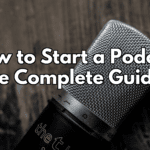Marry Podcast and Video at Home to Amplify Your Content

Last updated on October 24th, 2023
Podcasts have reached a new height of popularity over this past decade. Especially when you pair your podcast and video together.
They’ve taken over not only audio platforms like Spotify and Apple Music but video platforms like YouTube, too! Video podcasts add a whole new level of engagement and entertainment to an already beloved medium. If you’re a podcaster, you’re missing out by not utilizing video.
Here’s a quick guide on how to start your own video podcast.
How to Start a Video Podcast at Home
There are a few key differences between recording an audio and a video podcast. The main difference is that you have to record both audio and video. That means you need to focus on quality in two areas, rather than one.
Set Up a Studio for your Podcast and Video Podcast

With an audio-only podcast, nobody can see where you’re recording. You can record an audio podcast anywhere you want and it doesn’t matter. But with a video podcast, you want to look presentable and professional.
You need to set your camera up so that everyone involved in the podcast is visible on-screen. A classic method is to have everyone sit on one side of a table, with the camera pointed straight toward it. That way you don’t need to do any intricate camera switching to see everyone.
Another popular method — as you’ll see on video podcasts like the Joe Rogan Experience and the H3 Podcast — is to have the host on one side of the table, and the guest on the other. The two look at each other, with the camera capturing a side view. This looks great, but usually requires an off-screen camera switcher to flip between views.
That, or some intricate editing.
Get the Right Equipment
For a video podcast, you’ll need a good camera or two, high-quality audio equipment, and editing software. You may also need some accessories, like tripods, switchers, visual stimuli, and microphone arms.
You don’t have to break the bank, but you do need good quality equipment at least. Nobody wants to watch or listen to a podcast full of noise.
Edit & Upload
The editing process is a bit more strenuous on a video podcast than on an audio podcast. A podcast and video together require a bit more editing skill than with audio alone. It’s harder to cover up mistakes and splice different takes together.
With a video podcast, you have to think about audio sync on top of all the other usual editing. You might have to edit in more video clips if the podcaster is reacting to something, and you might have to edit color, contrast, and other general settings to get the best picture. You also have to put just as much effort as before into editing the audio, meaning, making it as clear as possible.
You’ll find Adobe Spark’s available tools very helpful in achieving this. They have tools that let you resize video online, and much more.
Once you’re all edited, it’s time to upload. You need a good title, a thumbnail, and some tags. Make sure your video follows all YouTube’s policies to get it monetized and ensure success.
Video Is the Present of Podcasting
The truth is, that video is the present and future of podcasting. People love having a visual component to their podcasts. Your podcast and video married together is the natural evolution of the medium. For better or worse. If you have a podcast going, turn it into a video podcast using the tips above.
For more on podcasts, including reviews and tips, check out the rest of our blog.













1 comment
Do you have a good started video camera that you recommend?
Comments are closed.